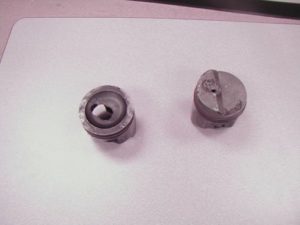Model Description
This is a training aid that can be used during the discussion of engine knock in internal combustion engines, and to show the severe damage it can cause to engine components. This demonstration should take 5-8 minutes.
Engineering Principle
Engine knock, or autoignition is the premature ignition of the fuel-air mixture in a reciprocating engine, and occurs when the temperature in the cylinder exceeds the autoignition temperature of the fuel-air mixture. This spontaneous ignition results in very high pressures within the cylinder and the “pinging” sound most people associate with engine knock. Autoignition is normally caused by high compression ratios, low octane fuel, or a combination of the two. High compression ratios can cause engine knock because the temperature at the end of compression is a function of the compression ratio. Using an ideal engine cycle analysis (Otto Cycle) and cold air standard assumptions, this temperature is found using the equation:
where:
= Temperature of fuel air mixture before compression
= Temperature following compression
r = compression ratio
k = ratio of specific heats (1.4 for air)
Based on this relationship, one can see that as the engine’s compression ratio increases, so does the temperature of the fuel air mixture. However, higher compression ratios also lead to higher net power output, which is why high performance engines normally have higher compression ratios (10+). To overcome the tendency for autoignition, these engines use high octane fuels. Octane rating is simply a measure of a fuel’s knock resistance – the higher the rating the more resistant a fuel is to engine knock. When the octane rating is too low for a given compression ratio, engine knock can occur. The resulting high pressures travel through the cylinder, placing severe stress on the engine. Additionally, the ignition occurs during the piston’s upstroke, which severely decreases the engine’s power output.
What You Need
| Item | Quantity | Description/Clarification |
|---|---|---|
| Damaged Engine Pistons | Various | Engine Knock can result in critical failure in several ways. Most pistons damaged due to knock will have holes in them. |
How It’s Done
Before Class: Obtain damaged piston(s) and place them out of sight to be pulled out at the appropriate time during class.
In Class: When discussing the concept of engine knock, address the effects of compression ratio and octane rating on engine performance. Pass the damaged piston(s) around the class.
Observations: Students can see the adverse effects of engine knock and the extreme results.

Additional Application: This class can also lead into a discussion of leaded fuels (high knock resistance but toxic by-products) and the advent of advanced refining methods to obtain higher octane fuels. This is a good way to tie in the social, political, and economic impact engineers have on society.
